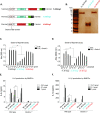Structural basis of Blastomyces Endoglucanase-2 adjuvancy in anti-fungal and -viral immunity
- PMID: 33735218
- PMCID: PMC8009368
- DOI: 10.1371/journal.ppat.1009324
Structural basis of Blastomyces Endoglucanase-2 adjuvancy in anti-fungal and -viral immunity
Abstract
The development of safe subunit vaccines requires adjuvants that augment immunogenicity of non-replicating protein-based antigens. Current vaccines against infectious diseases preferentially induce protective antibodies driven by adjuvants such as alum. However, the contribution of antibody to host defense is limited for certain classes of infectious diseases such as fungi, whereas animal studies and clinical observations implicate cellular immunity as an essential component of the resolution of fungal pathogens. Here, we decipher the structural bases of a newly identified glycoprotein ligand of Dectin-2 with potent adjuvancy, Blastomyces endoglucanase-2 (Bl-Eng2). We also pinpoint the developmental steps of antigen-specific CD4+ and CD8+ T responses augmented by Bl-Eng2 including expansion, differentiation and tissue residency. Dectin-2 ligation led to successful systemic and mucosal vaccination against invasive fungal infection and Influenza A infection, respectively. O-linked glycans on Bl-Eng2 applied at the skin and respiratory mucosa greatly augment vaccine subunit- induced protective immunity against lethal influenza and fungal pulmonary challenge.
Conflict of interest statement
The authors have declared that no competing interests exist.
Figures







Similar articles
-
Combination Adjuvants Enhance Recombinant Protein Vaccine Protection against Fungal Infection.mBio. 2021 Aug 31;12(4):e0201821. doi: 10.1128/mBio.02018-21. Epub 2021 Aug 17. mBio. 2021. PMID: 34399628 Free PMC article.
-
Ligation of Dectin-2 with a novel microbial ligand promotes adjuvant activity for vaccination.PLoS Pathog. 2017 Aug 9;13(8):e1006568. doi: 10.1371/journal.ppat.1006568. eCollection 2017 Aug. PLoS Pathog. 2017. PMID: 28793349 Free PMC article.
-
Tc17 cells mediate vaccine immunity against lethal fungal pneumonia in immune deficient hosts lacking CD4+ T cells.PLoS Pathog. 2012;8(7):e1002771. doi: 10.1371/journal.ppat.1002771. Epub 2012 Jul 19. PLoS Pathog. 2012. PMID: 22829762 Free PMC article.
-
Progress in vaccination for histoplasmosis and blastomycosis: coping with cellular immunity.Med Mycol. 2005 Aug;43(5):381-9. doi: 10.1080/13693780500245875. Med Mycol. 2005. PMID: 16178365 Review.
-
Meeting report and review: Immunological assays and correlates of protection for next-generation influenza vaccines.Influenza Other Respir Viruses. 2020 Mar;14(2):237-243. doi: 10.1111/irv.12706. Epub 2019 Dec 13. Influenza Other Respir Viruses. 2020. PMID: 31837101 Free PMC article. Review.
Cited by
-
Vaccine adjuvants to engage the cross-presentation pathway.Front Immunol. 2022 Aug 1;13:940047. doi: 10.3389/fimmu.2022.940047. eCollection 2022. Front Immunol. 2022. PMID: 35979365 Free PMC article. Review.
-
Immunity to fungi in the lung.Semin Immunol. 2023 Mar;66:101728. doi: 10.1016/j.smim.2023.101728. Epub 2023 Feb 24. Semin Immunol. 2023. PMID: 36841146 Free PMC article. Review.
-
They shall not grow mold: Soldiers of innate and adaptive immunity to fungi.Semin Immunol. 2023 Jan;65:101673. doi: 10.1016/j.smim.2022.101673. Epub 2022 Nov 29. Semin Immunol. 2023. PMID: 36459927 Free PMC article. Review.
-
T cell responses to control fungal infection in an immunological memory lens.Front Immunol. 2022 Sep 13;13:905867. doi: 10.3389/fimmu.2022.905867. eCollection 2022. Front Immunol. 2022. PMID: 36177012 Free PMC article. Review.
-
Vaccination with O-linked Mannans Protects against Systemic Candidiasis through Innate Lymphocyte Populations.J Immunol. 2024 Sep 15;213(6):843-852. doi: 10.4049/jimmunol.2400065. J Immunol. 2024. PMID: 39109925
References
Publication types
MeSH terms
Substances
Grants and funding
- R37 AI035681/AI/NIAID NIH HHS/United States
- R21 AI149793/AI/NIAID NIH HHS/United States
- U01 AI124299/AI/NIAID NIH HHS/United States
- U01 CA231081/CA/NCI NIH HHS/United States
- S10 RR029531/RR/NCRR NIH HHS/United States
- S10 OD018530/OD/NIH HHS/United States
- RF1 AG052324/AG/NIA NIH HHS/United States
- R01 AI035681/AI/NIAID NIH HHS/United States
- R01 AI093553/AI/NIAID NIH HHS/United States
- R01 AI025780/AI/NIAID NIH HHS/United States
- R24 GM137782/GM/NIGMS NIH HHS/United States
- R01 AI040996/AI/NIAID NIH HHS/United States
- R01 AI130411/AI/NIAID NIH HHS/United States
LinkOut - more resources
Full Text Sources
Other Literature Sources
Research Materials

